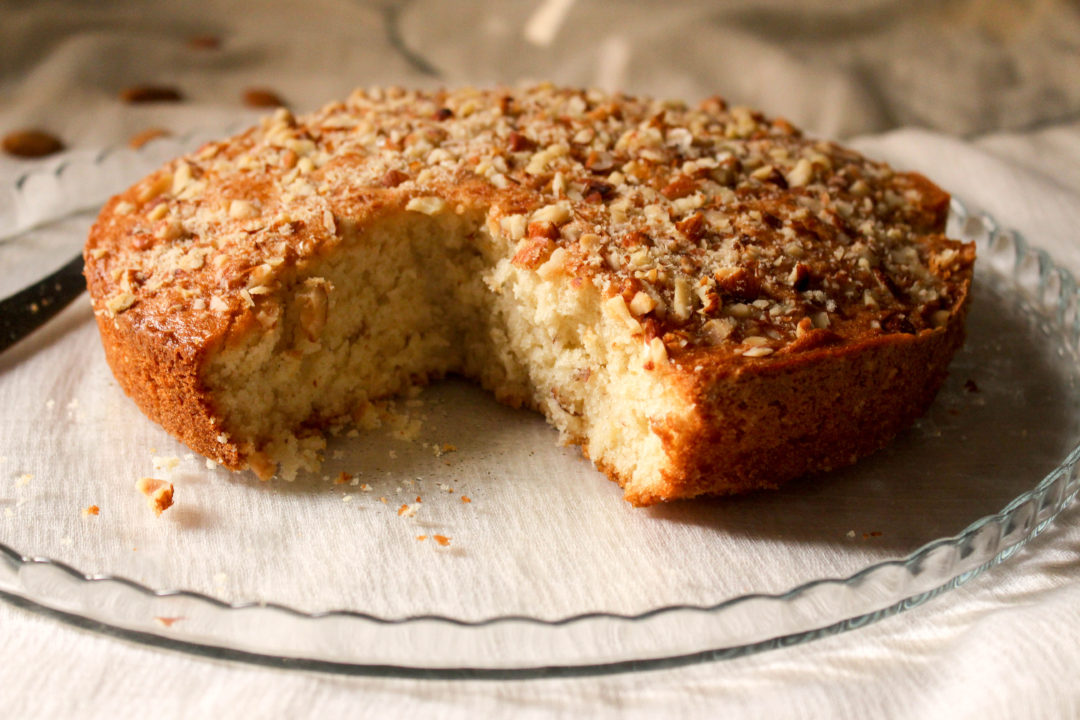Almond cake is a very healthy and tasty cake recipe. Today, let’s see how you can make it at your home.

Almond cake is soft, fluffy with finely grounded almonds and a dash of lemon flavor in it. It is also free of gluten. The recipe is a 4-ingredients recipe and the easiest one that you can make. You can serve it during tea time. Now, let’s have a quick overview of the recipe.
To make the almond cake, prepare a batter of almond flour, eggs, sugar, sliced almonds and lemon zest. Now, prepare an oven to 350˚F and bake the batter in a baking tray for 30 minutes. Garnish with powdered sugar and lemon slices.
The recipe is a 4-ingredients recipe and the easiest one you will find. If you want to make your almond cake completely vegan, you can use any of the vegan egg substitutes.
You can bake this cake without much hassle. It will be a great idea to include this cake in your high tea menu. If you love cakes, then you should definitely check out the other cake recipes that I’ve handpicked just for you.
1. Panda Cake– Make the best panda cake with this recipe. This cute and tasty cake is something that you and your kids can’t resist. These easy panda cakes will be fun to serve for Valentine’s Day, a baby shower, a birthday party, or Sweetest Day.
2. Saffron Milk Cake– Saffron Milk Cake is a version of tres leches cakes. It was originated in the Middle East. Looking at the cake, no one can resist a slice of it.
What's In The Post
Ingredients for Almond Cake
| Ingredients | Amount |
|---|---|
| Almond Flour | 1 ½ cups |
| Eggs | 4 separated at room temperature |
| Granulated Sugar | ½ cup |
| Lemon Zest | 1 tablespoon zest grated from 1 lemon |
| Sliced Almonds | ¼ cup |
| Confectioners Sugar and Lemon Slices | To garnish |
You can grab these ingredients at any supermarket. Or you may have them stocked up in your pantry already. You must be thinking about the time of preparation. So let’s take a look at that.
How Much Time It Will Take?
| Preparation Time | Cooking Time | Total Time |
|---|---|---|
| 10 minutes | 30 minutes | 40 minutes |
Baking a cake is one of my hobbies. So for me, time flies while baking. And this is the same with everyone who loves to bake. Baking this cake will take less than an hour. It is not a time consuming recipe. Check out the instructions and follow them precisely to bake a perfect cake.
Steps to Make Almond Cake

- Set the oven on preheat mode to 350˚F. Till then, grease a cake pan of 9 inches. Line a parchment paper on the bottom of the cake.
- Take a large bowl. Add 4 egg yolks with ½ cup of sugar in them. Beat them with the help of an electric mixer for 3 minutes at high speed. Make sure it turns out thick, creamy and light in color. To this, add 1 ½ cup of almond flour and lemon zest. With the help of a spatula, fold and stir the mixture.
- Take another large bowl. To it, add 4 egg whites and beat them till it makes stiff peaks of form. Take 1 heaped tablespoon of egg white foam at a time and mix it into the batter. Repeat this till you add the whole bowl of egg white foam into the batter. Mix well so that they get incorporated well.
- Now, transfer this batter to the baking pan and sprinkle sliced almonds. Bake it for 30 minutes at 350˚F or bake till the top gets firm.
- Before taking the cake out of the baking pan, let the cake pan rest for 15 minutes. Run a spatula around the sides of the cake and flip it over your hand. Now, flip the back on the rack with its right side up. Cool the cake to room temperature.
- Garnish with powdered sugar and lemon slices. Serve.
You must be eager to have a slice of it. I can’t wait to grab a cup of coffee with a slice of this cake. From a kid in your family to an old member, they will enjoy a slice in their way. This cake will is healthy, being a gluten-free cake.
Nutritional Breakdown of Almond Cake
| Calories | 218 |
| Protein | 7g |
| Carbohydrates | 17g |
| Fat | 14g |
| Cholesterol | 81mg |
| Sodium | 31mg |
How to Make Almond Cake at Home | Video
In case you find something confusing, I have uploaded the video of this cake recipe.
Your doubts are most welcome in my comment section below. So write them up and I will be replying to them with my best knowledge. There are other cake recipes with different baking styles. Do give it a try and share its reviews too. Till then, enjoy your slice of cake.

